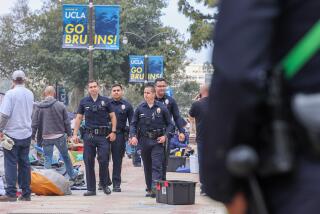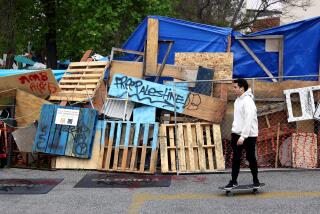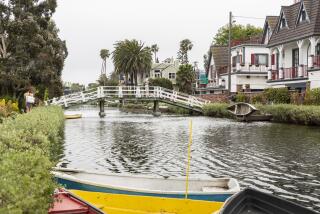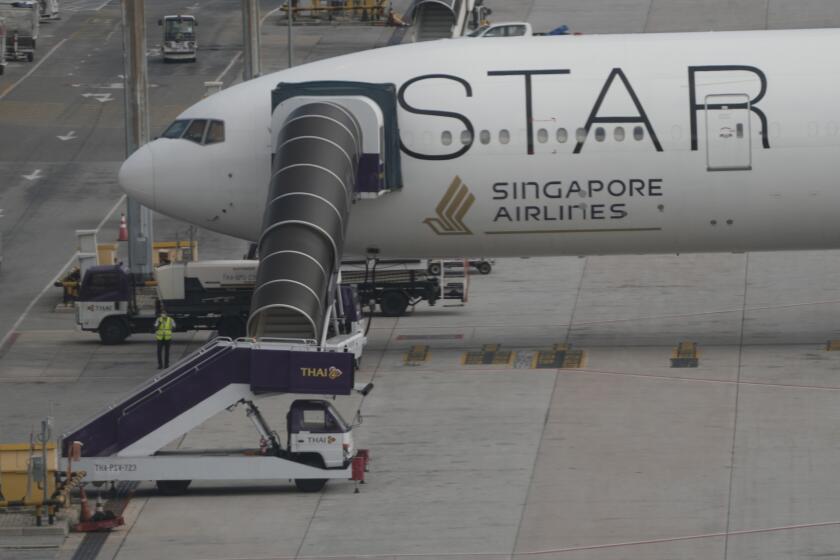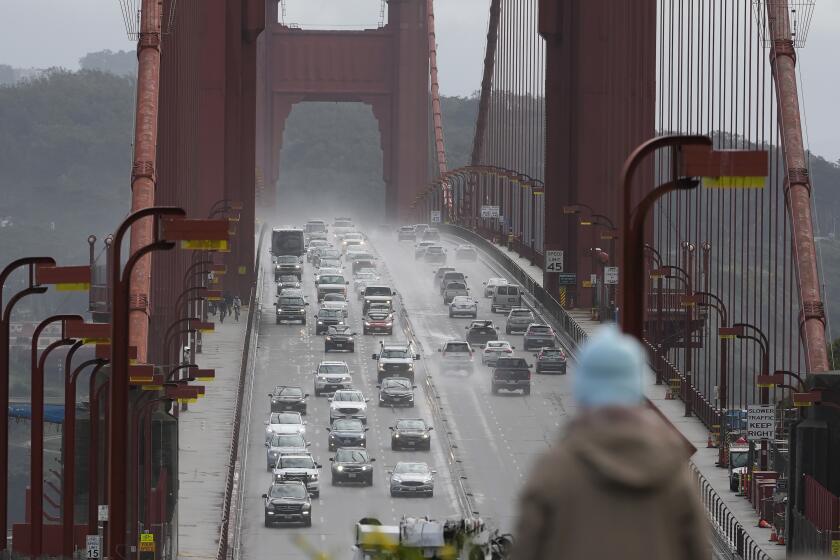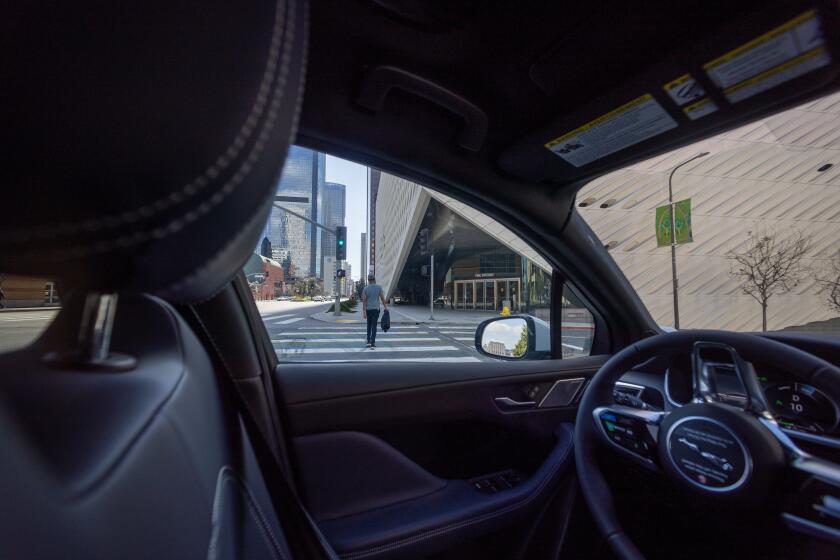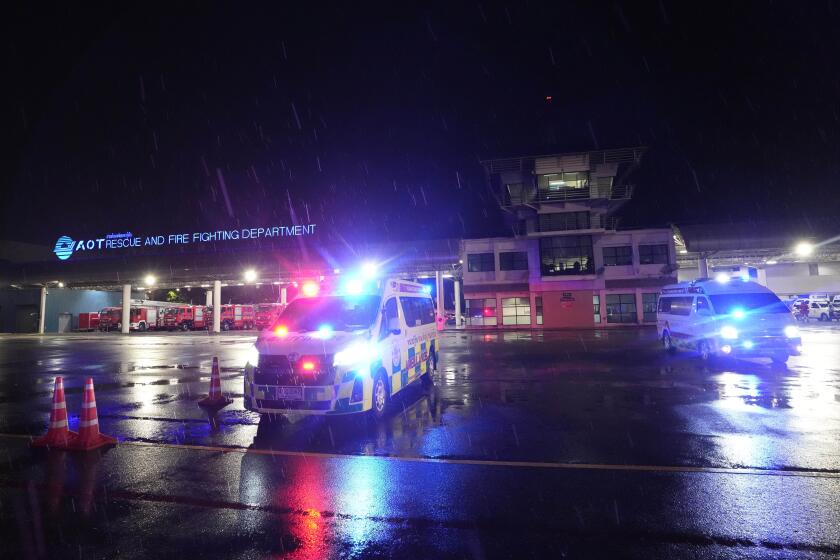A County of Spite, Road Rage
Furious city officials in Alhambra and equally furious city officials in South Pasadena escalated a 35-year war of legal briefs and environmental-impact reports last month across barricades blocking Valley Boulevard at the ragged end of the 710 Freeway. The confrontation lacked only the singing of La Marseillaise by beleaguered Alhambrans.
The shouted curses of frustrated commuters and horns honking sounded an appropriate L.A. substitute.
“See how they like it,” loyalists said of Alhambra’s apparent intention to relocate their daily gridlock to South Pasadena until the 6.2-mile extension to the 710 Freeway is completed. “Says you,” the South Pasadenans replied, as they have since 1973 when activist residents first stopped the freeway’s extension from crossing their 3.44 square miles of hometown.
“Doh,” to quote Homer Simpson, best describes the blockade’s failure as traffic inched past languishing Alhambra businesses, many minority-owned, that depend on easy commuter access.
The barricades came down at the terminus of the freeway only four days after they went up. Even then, Mayor Mark Paulson of Alhambra was planning a rear-guard maneuver. The signals along the two miles of surface streets in Alhambra that bear the most traffic in and out of the city would be “synchronized.” To ease gridlock, he said.
Traffic signalization is supposed to be optimized, and there are pages of rules in state highway manuals to enforce the planner’s dream that traffic will flow free. There’s even federal highway money to install sophisticated traffic lights that regulate the flow of cars based on the computer intelligence of “expert systems.” The lights they synchronize pass more cars per minute past a given point than random signal patterns.
Alhambra has programmed just seven seconds of green into the lights on streets that lead to South Pasadena.
Irritating motorists isn’t much of a tactic after so many years of mutual road rage. But it’s all that Alhambra can do after U.S. District Judge Dean D. Pregerson ordered Caltrans to stop property acquisition and construction spending until he evaluates alternative plans to the freeway-extension project. That may take another generation.
Cities don’t routinely engage in the sort of guerrilla action Alhambra took against its neighbor. The cities of the Los Angeles Basin occasionally sue each other. They sometimes write critical and pointless comments on each other’s environmental documents. They say mean things about each other in the relative privacy of city council meetings. That’s how they used to deal with the injustices of their neighbor’s size, political influence in Sacramento or good luck.
Like most political theater in L.A., the purpose of Alhambra’s barricades and signal synchronization is not to affect opinions in South Pasadena but to show the passionate 1% of Alhambra voters that city hall has done everything . . . everything . . . to get what the passionate desire. “Don’t blame us,” I can hear frustrated city officials say, “if we’re defeated by forces beyond our control. We did everything we could.”
The history of Los Angeles County enables its cities to appeal to such victimhood. Most of the county’s 88 sovereignties got that way, beginning in the 1880s, because one town’s saloons, sewage-treatment plant, off-kilter politics or racial ambiguities conflicted with another town’s vision of being the perfect place to sell house lots to the next wave of infatuated newcomers.
South Pasadena resisted inheriting the saloons of Pasadena when that city’s sober hypocrites incorporated it as a dry town in 1886. South Pasadena became a city two years later with 500 irate residents. Alhambra incorporated in 1903, preempting annexation by Los Angeles, and immediately began annexing neighboring communities to become the industrial center of the San Gabriel Valley. San Marino and San Gabriel incorporated in 1913 to retaliate against the ambitions of “Greater Alhambra.” They all resisted the hegemony of Los Angeles, which sought to annex Alhambra twice and South Pasadena once after both had been incorporated.
Multiply these grievances by 88 and you have this county of spite.
It may seem silly to recall turn-of-the-century conflicts to explain opposition to a freeway in 1999, especially since bigger Alhambra (population: 90,000) is now overwhelmingly minority and not quite middle class, while smaller South Pasadena (25,000) has grown more upscale and Anglo (from 62% to 66% since the 1990 Census). But race and class aren’t enough to explain the antagonism between the two cities, or the ruckus that might erupt along other tense borders in the county.
The history of transportation planning in L.A. slaps Alhambrans in the face twice a day, when their city’s streets fill with cars that should be on the 710 Freeway and on their way to the 210. Those motorists curse the frustrations of the freeway system not knowing that it follows routes suggested by the Automobile Club of Southern California in the mid-1920s and confirmed by county transportation officials in 1929. The commutes handed motorists today would seem less endless if planners had not assumed that downtown L.A. would always be the hub of the county. It wasn’t even then, but the planners hoped.
All parties to the 710 Freeway conflict appeal to plans. South Pasadena and the National Trust for Historic Preservation have a “low build” plan that redraws the grid of streets in Alhambra and trusts tightly synchronized traffic signals and more light rail to preclude the need for a freeway extension. Caltrans has two dozen plans for the freeway, framed by court orders and the agency’s responses to decades of political pressure. Above all, Caltrans has the planners’ yearning to fill the gaps in the great design of 60 years ago.
There have been, it now seems obvious, too many studies and too many plans. The arrows to the offramp from this impasse point in every direction.
What’s lacking is not a plan, but the consensus to act on one . . . any one. Until the collapse in the mid-1970s of the real estate-government complex that drove the county’s development for 100 years, the plan of Los Angeles got built even though building it made permanent yesterday’s assumptions about today. Developers were the Hapsburg archdukes of an empire of growth. The county today is the Balkans without them.
After the collapse of L.A.’s “growth machine,” the homeowner determinism of South Pasadenans, and not any vision for the future of the region, defines the limit of what we do here. Some urban planners offer the hope that a regional land-use agency might fill the gap left behind.
Another regional agency, with the political power to resolve the 710 Freeway conflict, would accrete another, equally indelible layer of planning over the county. It would do South Pasadena no good, since a majority of cities in the San Gabriel Valley has already endorsed the freeway extension. Those cities, with their inherited grievances, would be voting members of any regional planning agency.
The old growth machine processed dirt into house lots through massive government subsidization of infrastructure, principally water systems and highways. (It still does on the region’s frontiers.) The machine faltered in Los Angeles County when it ran out of cheap dirt and into homeowners ready to fight any attempt to fill the gaps in all the plans.
The fight will continue on the Alhambra-South Pasadena front, and across every gap in the county, until we know what kind of L.A. we have and what kind of L.A. we want.*
More to Read
Start your day right
Sign up for Essential California for news, features and recommendations from the L.A. Times and beyond in your inbox six days a week.
You may occasionally receive promotional content from the Los Angeles Times.
